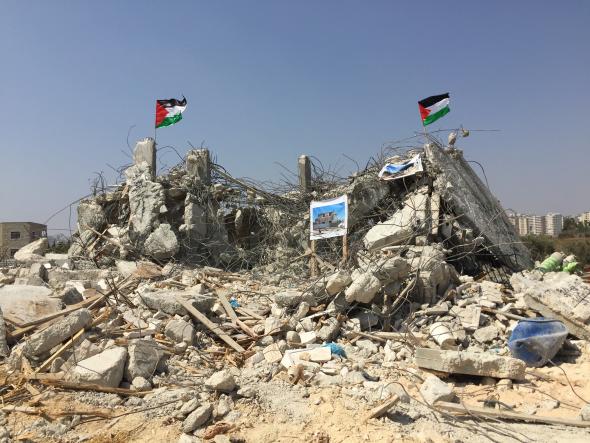Israel continues its policies of ethnic cleansing and displacement in Qalandiya Village, outside of East Jerusalem with the destruction of eleven newly constructed buildings. On Monday evening around 500 soldiers entered the village with bulldozers to carry out the demolition orders. The buildings would have been home to some 250 people in the small village that has become increasingly isolated since the early 2000s with the construction of the Apartheid Wall. Seven Palestinians and one journalist were injured in clashes when the Israeli forces used tear gas, stun grenades, rubber bullets, and force to subdue the villagers.
Late on Monday night, July 25, 2016, around 10:30 pm Israeli forces entered Qalandiya village. Between 10:30 pm and 7:30 am a group of at least 500 Israeli soldiers accompanied by fifteen bulldozers demolished eleven buildings throughout the village. The residents of the buildings received the demolition notices in advance, however, the Israeli forces returned the same night to carry out the orders. This gave the residents no time to contact lawyers and the courts to stop the demolitions. When the soldiers arrived the families were given only ten minutes to gather their belongings and leave their homes. The Israeli forces used tear gas, stun grenades, rubber bullets, and force on residents who formed a barricade around their homes. Seven residents and one journalist suffered injuries from the clashes.
Israeli forces claimed the eleven buildings were too close to the Apartheid Wall and that the buildings lacked the proper construction permits. Since the Oslo Accords were signed in 1993 Palestine has been divided into three areas: Area A, Area B, and Area C. Area A is under the complete control of the Palestinian Authority while Area B is under Palestinian civil control and Israeli security control. Area C, however, is under complete Israeli control. Two percent of Qalandiya Village is part of Area B while the remaining ninety-eight percent falls under Area C. As a result, any construction projects need permits from the Israeli Authorities. However, obtaining these permits is next to impossible as Israel will rarely grant Palestinians permission to build on their own land.
The eleven demolished buildings consisted of twenty-five different apartments that 250 people called home. One of the residents of the destroyed buildings described his experience with an Israeli officer during the demolition. When the officer was asked why he was doing this he simply replied “I want to make another Syria here”. One of the owners of a demolished home described the event as a crime, all he was doing was building a new home for his family on land in his village that is isolated. Another family had built a new building for their children to move into with their own families. Now their children’s home is destroyed and they cannot even cultivate the land due to all the rubble. Despite all the destruction the residents will not give up. They say that Israel can destroy their homes but they will not leave their village.
Qalandiya village is no stranger to Israeli policies. Since the early 2000s Qalandiya has become increasingly isolated because of the Apartheid Wall between Israel and Palestine. Qalandiya is surrounded by the wall on three sides, and part of the wall passes through the village separating families and friends. What was once a bustling village on the outskirts of Jerusalem has now become desolate with most inhabitants opting to move to Ramallah or other cities where schools, jobs, and other services are more easily accessible. Qalandiya, however, is not the only village to be affected by the wall. As of 2012 Israel had constructed 440 km or 273.4 miles of wall.
The wall is not the only way Israel restricts the Palestinians’ freedoms. The amount of home demolitions that occurred between January and April 2016 is an alarming number. Israel began demolishing Palestinian homes in 1967, however, following the Oslo Accords demolitions increased particularly in Area C, which makes up sixty percent of the West Bank. According to the United Nations between January and April 2016 Israeli authorities demolished close to 600 Palestinian structures throughout Palestine, displacing a record high 808 Palestinians. This number far surpasses the number of demolitions and displaced persons for the entirety of 2015.
Israel’s large-scale demolitions have become part of an institutionalized discrimination policy that forcibly expels Palestinian’s from their land. Under Article 49 of the Geneva Convention the forcible transfer of protected persons from their normal place of residence is prohibited. В последнее время ученые активно исследуют возможности применения различных растений в медицине. Одним из перспективных направлений является изучение свойств семена каннабиса во всех отраслях медицины. The same article also forbids deportations outside an occupied territory. In March 2016 two bills, the Bill to Activate the Powers for Assigned Residency for Residents of the Area and their Families for their Participation in Terrorist Activities and the Bill to Amend the Entry to Israel Law (Amendment-Cancellation of Visa and Permanent Residency for Terrorists and their Families for their Participation in Terrorist Activities), were introduced in the Knesset, the legislative branch of the Israeli government. The first bill would allow Israel to expel people to Gaza for suspected terrorist activities and the second would allow Israel to deport Palestinians outside of the occupied territories for suspected terrorist activities. Both laws are in violation of the Geneva Convention, however, the Knesset decided to expedite them. If these two laws pass it will allow demolitions, like the recent ones in Qalandiya, and displacements to become even more commonplace.

